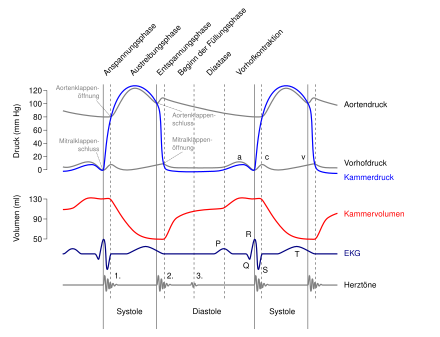Carl J. Wiggers
Carl John Wiggers (born May 28, 1883 in Davenport , Iowa , † April 28, 1963 in Cleveland , Ohio ) was an American physiologist . He was able to make significant contributions to the understanding of the physiology of the cardiovascular system .
Life
Carl J. Wiggers was the child of German immigrants from Holstein , Carl's father Jürgen ran a restaurant in Davenport. Carl J. Wiggers obtained an MD in 1906 at the University of Michigan in Ann Arbor , where he then worked as a lecturer for five years - interrupted by a stay with Otto Frank at the Physiological Institute of the Ludwig Maximilians University in Munich . In 1911, Wiggers went to Graham Lusk at Cornell Medical School in New York City , where he became an assistant professor in 1913 , before becoming a professor at Western Reserve University in Cleveland in 1917 , which he held until his retirement in 1953. He was succeeded by George Sayers . Wiggers himself took on an honorary professorship at the Frank E. Bunts Educational Institute in Cleveland.
In 1907 Wiggers married Minerva E. Berry, the couple had two sons. Harold Wiggers himself became professor of physiology and in 1953 dean of Albany Medical College (now University at Albany, The State University of New York ). Raymond Wiggers became an advertising specialist.
Act
Wiggers published his first scientific papers as a student; as a young lecturer, he distinguished himself through didactic skills. In Munich, Wiggers studied non-invasive methods of measuring pressure ( sphygmography ) and was later able to refine the method. He examined the function of the heart in healthy people ( physiology ) and sick people ( pathophysiology ). The simultaneous recording of pressure and volume curves in different parts of the heart and the central vessels with an electrocardiogram and heart sounds is still used today as a Wiggers diagram in clinical, didactic and scientific applications. With his investigations, Wiggers was able to strengthen Thomas Lewis's position towards Willem Einthoven that the electrical activity of the heart precedes the contraction in time.
With the entry of the United States into World War I , Wiggers turned to the study of the soldier's heart ( cardiophobia ) and hemorrhagic shock . In Wigger's department at Western Reserve University , around 400 papers on the entire physiology of the cardiovascular system have been published in the 35 years he has worked there, and various apparatuses have been developed to investigate the system. The division of the cardiac cycle into phases such as the tension phase, expulsion phase or relaxation phase goes back to Wiggers.
Wiggers carried out initial work on the cause and treatment of ventricular fibrillation and was able to show that improved oxygen supply to the heart increased the likelihood that electrical defibrillation would be successful. Wiggers proposed to maintain a perfusion of the aorta and central vessels by means of rhythmic compression of the thorax and with his work created the foundations of cardiopulmonary resuscitation , monitoring , pacemaker therapy and planned cardiac arrest for open heart operations.
Wiggers held numerous functions for the American Physiological Society : member of the advisory board, treasurer, general secretary and 1949/1950 president. Wiggers was one of the editors of scientific journals American Journal of Physiology and - he founded the - American Heart Journal and Circulation Research .
Awards (selection)
- 1951 member of the National Academy of Sciences
- 1952 Gold Heart Award of the American Heart Association
- 1954 Carl Ludwig Medal of the German Society for Circulatory Research
- 1955 Albert Lasker Award for Basic Medical Research
- Honorary doctorates from the University of Michigan (1951), the Ludwig Maximilians University of Munich (1952), the Université libre de Bruxelles (1956) and the Ohio State University (1958)
The Western Reserve University awards the since 1952 Minerva and Carl Wiggers Prize in Physiology for students. The Cardiovascular Physiology Section of the American Physiological Society has been awarding its highest honor since 1966, the Carl J. Wiggers Memorial Award to members of the society who can look back on an outstanding scientific life's work in the field of cardiovascular physiology.
Writings (monographs)
- A Brief Text of Physiology (1914)
- Modern Aspects of the Circulation in Health and Disease (two editions, 1915 and 1923)
- Pressure Pulses in the Cardiovascular System (1928)
- Principles and Practice of Electrocardiography (1929)
- Physiology in Health and Disease (five editions, 1934-1949)
- Physiology of Shock (1950)
- Circulatory Dynamics (1952)
- Reminiscences and Adventures in Circulation Research (autobiography, 1958)
literature
- Eugene M. Landis: Carl John Wiggers 1883-1963. In: Biographical Memoir. National Academy of Sciences, 1976 (PDF, 1.5 MB)
Web links
- Carl J. Wiggers, 21st APS President (1949-1950) at the American Physiological Society (the-aps.org); Retrieved June 17, 2012
Individual evidence
- ^ Lasker Foundation: Cardiovascular physiology - The Lasker Foundation. In: laskerfoundation.org. Retrieved April 3, 2018 .
- ↑ Graduating Student Awards ( memento February 15, 2016 in the Internet Archive ) at Case Western Reserve University (cwru.edu); Retrieved June 18, 2012
- ^ Carl J. Wiggers Award at the American Physiological Society (the-aps.org); accessed on July 12, 2018.
- ^ Recipients of the Carl J. Wiggers Memorial Award at the American Physiological Society (the-aps.org); accessed on July 12, 2018.
| personal data | |
|---|---|
| SURNAME | Wiggers, Carl J. |
| ALTERNATIVE NAMES | Wiggers, Carl John (full name) |
| BRIEF DESCRIPTION | American physiologist |
| DATE OF BIRTH | May 28, 1883 |
| PLACE OF BIRTH | Davenport , Iowa |
| DATE OF DEATH | April 28, 1963 |
| Place of death | Cleveland , Ohio |
